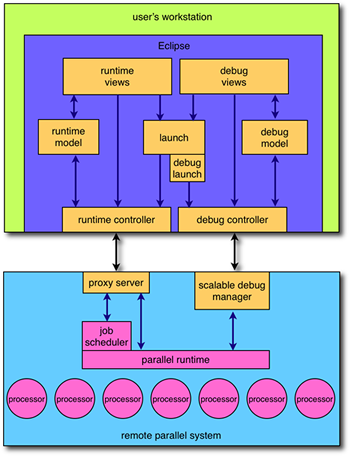Notice: This Wiki is now read only and edits are no longer possible. Please see: https://gitlab.eclipse.org/eclipsefdn/helpdesk/-/wikis/Wiki-shutdown-plan for the plan.
PTP/designs/2.x
Contents
Overview
The Parallel Tools Platform (PTP) is a portable, scalable, standards-based integrated development environment specifically suited for application development for parallel computer architectures. The PTP combines existing functionality in the Eclipse Platform, the C/C++ Development Tools, and new services specifically designed to interface with parallel computing systems, to enable the development of parallel programs suitable for a range of scientific, engineering and commercial applications.
This document provides a detailed design description of the major elements of the Parallel Tools Platform version 2.x.
Architecture
The Parallel Tools Platform provides an Eclipse-based environment for supporting the integration of development tools that interact with parallel computer systems. PTP provides pre-installed tools for launching, controlling, monitoring, and debugging parallel applications. A number of services and extension points are also provided to enable other tools to be integrated with Eclipse an fully utilize the PTP functionality.
Unlike traditional computer systems, launching a parallel program is a complicated process. Although there is some standardization in the way to write parallel codes (such as MPI), there is little standardization in how to launch, control and interact with a parallel program. To further complicate matters, many parallel systems employ some form of resource allocation system, such as a job scheduler, and in many cases execution of the parallel program must be managed by the resource allocation system, rather than by direct invocation by the user.
In most parallel computing environments, the parallel computer system is remote from the user's location. This necessitates that the parallel runtime environment be able to communicate with the parallel computer system remotely.
The PTP architecture has been designed to address these requirements. The following diagram provides an overview of the overall architecture.
The architecture can be roughly divided into three major components: the runtime platform, the debug platform, and tool integration services. These components are defined in more detail in the following sections.
Runtime Platform
This section describes the runtime monitoring and control features of PTP.
Launch Platform
This section describes the services for launching debug and non-debug jobs.
Debug Platform
This section describes the features and operation of the PTP parallel debugger.
Remote Services
This section describes the remote services framework that PTP uses for communication with remote systems.

